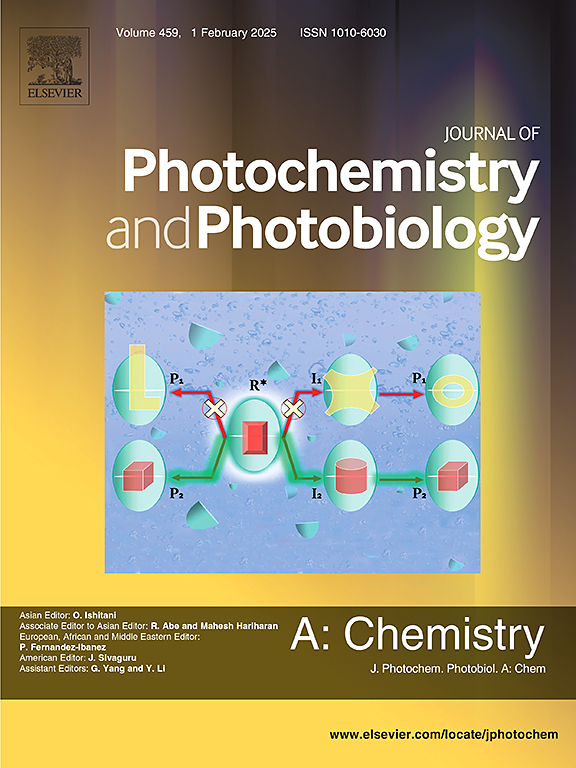Synthesis of Bi2Se3 quantum dots as a highly selective luminescence probe of 1-chloro-2,4-dinitrobenzene
IF 4.1
3区 化学
Q2 CHEMISTRY, PHYSICAL
Journal of Photochemistry and Photobiology A-chemistry
Pub Date : 2025-05-24
DOI:10.1016/j.jphotochem.2025.116518
引用次数: 0
Abstract
1-Chloro-2,4-dinitrobenzene (CDNB) is a highly allergenic compound, it is widely used for the quantitative detection of glutathione-s-transferase. This chemical in environment can cause serious effects on human health. High-performance liquid chromatography (HPLC) with ultra violet detector has been used to detect CNDB, and the limit of the detection (LOD) is 200 ng/ml. It is significant to find a simple and quick method to detect CDNB. It is still a challenge to detect CDNB from nitroaromatic compounds with alike structure of CDNB using luminescent probe method. In this work, yellow-green Bi2Se3 quantum dots (QDs) were firstly synthesized by solvothermal method, and its absolute luminescence quantum yield reached 13.8 ± 0.2 %. Bi2Se3 QDs are environmentally friendly luminescent materials. The luminescence of the Bi2Se3 QDs solution was selectively quenched by CDNB molecules, CDNB could be selectively detected using Bi2Se3 QDs as luminescent probe. The linear range was 0.040 ∼ 0.50 μM, and the detection limit was 0.03 μM. Some nitroaromatic compounds including 4-fluoro-1,2-dinitrobenzene (4-F-1,2-DNB), 1,3-dinitrobenzene (1,3-DNB), 2,6-dinitroaniline (2,6-DNA), p-chloronitrobenzene (p-CNB), 1-methyl-4-nitrobenzene (1-M−4−NB), 1-iodo-4-nitrobenzene (1-I-4-NB) and 1-(4-nitro-phenyl)-ethanone (4-NPE) did not interfere with the detection of CDNB. The detection of CDNB was interfered slightly only by 2,4-dinitroaniline (2,4-DNA) due to inner filter effect. The reason for the highly selective detection of CDNB using Bi2Se3 QDs was investigated detailed. The result provides a new sight for finding highly selective luminescent probe for organic chemicals based on the intermediate state formed between the surfaces of luminescent Bi2Se3 QDs and organic molecules through the characteristic second bond. Bi2Se3 QDs provide a new candidate for highly selective luminescent probe of CDNB with low limit of detection of 6.08 ng/ml.

作为1-氯-2,4-二硝基苯高选择性发光探针的Bi2Se3量子点的合成
1-氯-2,4-二硝基苯(CDNB)是一种高致敏性化合物,广泛用于谷胱甘肽-s转移酶的定量检测。环境中的这种化学物质会对人体健康造成严重影响。采用高效液相色谱-紫外检测器对CNDB进行检测,检出限(LOD)为200 ng/ml。寻找一种简便、快速的CDNB检测方法具有重要意义。利用发光探针法从结构相似的硝基芳香族化合物中检测CDNB仍然是一个挑战。本文首次采用溶剂热法合成了黄绿色Bi2Se3量子点,其绝对发光量子产率达到13.8±0.2%。Bi2Se3量子点是一种环保发光材料。Bi2Se3量子点溶液的发光被CDNB分子选择性猝灭,利用Bi2Se3量子点作为发光探针可以选择性地检测CDNB。线性范围为0.040 ~ 0.50 μM,检出限为0.03 μM。一些硝基芳香族化合物包括4-氟-1,2-二硝基苯(4- f -1,2- dnb)、1,3-二硝基苯(1,3- dnb)、2,6-二硝基苯胺(2,6- dna)、对氯硝基苯(p-CNB)、1-甲基-4-硝基苯(1- m−4−NB)、1-碘-4-硝基苯(1- i -4-NB)和1-(4-硝基苯基)-乙烷(4- npe)对CDNB的检测没有干扰。由于内部过滤作用,只有2,4-二硝基苯胺(2,4- dna)对CDNB的检测有轻微干扰。详细探讨了利用Bi2Se3量子点高选择性检测CDNB的原因。基于发光Bi2Se3量子点与有机分子之间通过特征二键形成的中间态,为寻找高选择性的有机化学发光探针提供了新的视角。Bi2Se3量子点为CDNB的高选择性发光探针提供了新的候选物,低检出限为6.08 ng/ml。
本文章由计算机程序翻译,如有差异,请以英文原文为准。
求助全文
约1分钟内获得全文
求助全文
来源期刊
CiteScore
7.90
自引率
7.00%
发文量
580
审稿时长
48 days
期刊介绍:
JPPA publishes the results of fundamental studies on all aspects of chemical phenomena induced by interactions between light and molecules/matter of all kinds.
All systems capable of being described at the molecular or integrated multimolecular level are appropriate for the journal. This includes all molecular chemical species as well as biomolecular, supramolecular, polymer and other macromolecular systems, as well as solid state photochemistry. In addition, the journal publishes studies of semiconductor and other photoactive organic and inorganic materials, photocatalysis (organic, inorganic, supramolecular and superconductor).
The scope includes condensed and gas phase photochemistry, as well as synchrotron radiation chemistry. A broad range of processes and techniques in photochemistry are covered such as light induced energy, electron and proton transfer; nonlinear photochemical behavior; mechanistic investigation of photochemical reactions and identification of the products of photochemical reactions; quantum yield determinations and measurements of rate constants for primary and secondary photochemical processes; steady-state and time-resolved emission, ultrafast spectroscopic methods, single molecule spectroscopy, time resolved X-ray diffraction, luminescence microscopy, and scattering spectroscopy applied to photochemistry. Papers in emerging and applied areas such as luminescent sensors, electroluminescence, solar energy conversion, atmospheric photochemistry, environmental remediation, and related photocatalytic chemistry are also welcome.

 求助内容:
求助内容: 应助结果提醒方式:
应助结果提醒方式:


